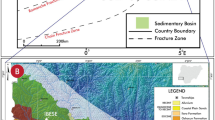Abstract
Quantitative analyses of microfossils and stable isotopic analysis were carried out for Core SCS-12 in the southwestern slope of the South China Sea (SCS). A high-resolution paleoceanographic record for the last 13 ka was revealed with the AMS14C dates. The southern SCS has experienced stepwise paleoceanographic changes since the last deglaciation. The oxygen isotopic stage 1/2 boundary around 12.05 ka B. P. and the end of the last deglaciation around 7.70 ka B.P. are two rapid change periods (corresponding to the terminationIa and terminationIb, respectively), in between is a slow change period. The authors infer that the sea level stood at - 110 m before the terminationIa, roughly the same as today after the termination IB, and about - 50 m in between. Subsequently, the average winter sea surface temperature and salinity obviously increased while paleo-productivity decreased since 12.05 ka B.P. The early Holocene CaCO3 preservation spike, coupled with a high abundance of pteropoda and CaCO3 content, occurred around 7.70 ka B. P.
Similar content being viewed by others
References
Ruddiman, W. F., Wright, H. E. Jr., Introduction, inNorth America and Adjacent Ocean During the last Deglaciation (eds. Ruddiman, W. F., Wright, H. E. Jr.), Colorado: Geol. Soc. Amer., 1988, 1.
Wang, L., Wang, P., Late Quaternary paleoceanography of the South China Sea: Glacial-interglacial contrasts in an enclosed basin,Paleoceanography, 1990, 5(1): 77.
Wang, L., Bian, Y., Wang, P., The last deglaciation in the South China Sea and the rapid climate return event (in Chinese with English abstract),Quat. Sci., 1994, 1:1.
Broecker, W. S., Andree, M., Klas, M. et al., New evidence from the South China Sea for an abrupt termination of the last glacial period,Nature, 1988, 333: 156.
Wang, P., The role of west Pacific marginal seas in glacial aridification of China: A preliminary study (in Chinese with English abstract),Quat. Sci., 1995, 1: 32.
Be, A. W. H., An ecological, zoogeographic and taxonomic review of Recent planktonic foraminifera, inOceanic Micropaleontology (ed. Ramsay, A. T. S.), London: Academic Press, 1977, 1: 1.
Herguera, J. C., Berger, W., Paleoproductivity from benthic foraminifera abundance: Glacial to postglacial change in the west-equatorial Pacific,Geol., 1991, 19: 1173.
Martinson, D. G., Piasias, N. G., Hays, J. D. et al., Age dating and the orbital theory of the ice ages: development of a high-resolution 0 to 300,000-year chronostratigraphy,Quat. Res., 1987, 27: 1.
Jian, Z., Li, B., Pflaumann, U. et al., Late Holocene cooling event in the western Pacific,Science in China, Ser. D, 1996, 39(5): 543.
Duplessy, J. C., Delibrias, G., Turon, J. L. et al., Deglacial warming of the northeastern Atlantic Ocean: Correlation with the paleoclimate evolution of European continent,Palaeogeogr. Palaeoclimatol. Palaeoecol., 1981, 35: 121.
Mix, A. C., The oxygen-isotope record of glaciation, inNorth America and Adjacent Ocean During the Last Deglaciation (eds. Ruddiman, W. F., Wright, H. E. Jr.), Colorado: Geol. Soc. Amer., 1988, 111.
Fairbanks, R. A., 17. 000 year glacial-eustatic sea level record: influence of glacial melting rates on Younger Dryas event and deep-ocean circulation,Nature, 1989, 342: 637.
Miao, Q., Thunell, R. C., Glacial-Holocene carbonate dissolution and sea surface temperatures in the South China and Sulu seas,Paleoceanography, 1994, 9(2): 269.
Broecker, W. S., Lao, Y., Klas, M. et al., A search for an early Holocene CaCO3 preservation event,Paleoceanography, 1993, 8(3): 333.
Rottman, M. L., Dissolution of planktonic foraminifera and pteropods in South China Sea sediments,J. Foraminiferal. Res., 1979, 9(1): 41.
Wang, P., Bian, Y., Li, B. et al., The Younger Dryas in the West Pacific marginal seas,Science in China, Ser.D, 1996, 39(5): 522.
Zhou, W., Li, X., Dong, G. et al., High-resolution records of peat in the desert/loess transition zone during the Younger Dryas period—an example of East Asian monsoonal climatic oscillationsScience in China (in Chinese), Ser. D, 1996, 26(2): 118.
Author information
Authors and Affiliations
Additional information
Project supported by the National Natural Science Foundation of China (Grant Nos. 49576286 and 49732086).
Rights and permissions
About this article
Cite this article
Jian, Z., Chen, M., Lin, H. et al. Stepwise paleoceanographic changes during the last deglaciation in the southern South China Sea Records of stable isotope and microfossils. Sci. China Ser. D-Earth Sci. 41, 187–194 (1998). https://doi.org/10.1007/BF02932439
Received:
Revised:
Issue Date:
DOI: https://doi.org/10.1007/BF02932439




